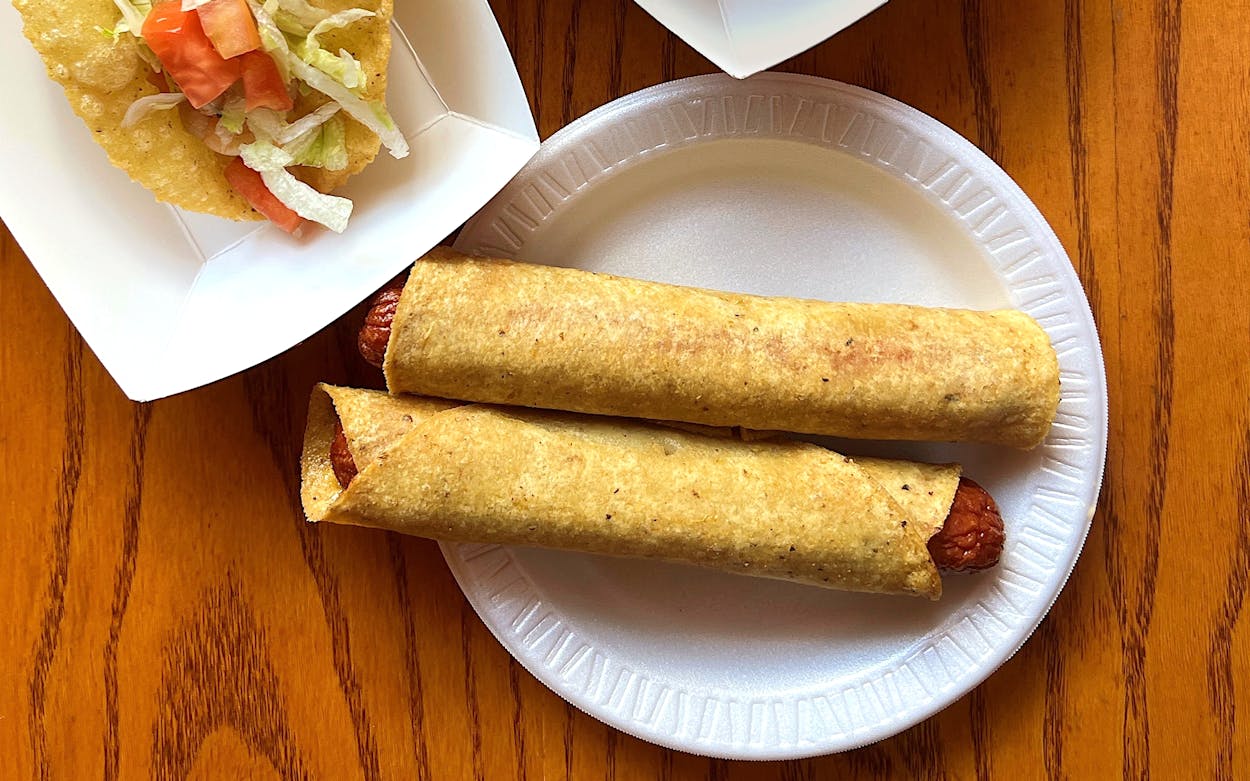By the time Ray Lopez put the crispy dog on the menu at his namesake Ray’s Drive Inn in 1956, it was already an iconic San Antonio food. The dish—an American cheese–stuffed frankfurter that’s wrapped in a corn tortilla and deep-fried—might not have been held in as high regard as Lopez’s puffy taco, but denizens of the Alamo City hankered for it. They continue to do so. Lopez’s niece and the restaurant’s current co-owner, Maria Lopez-Rambo, tells me crispy dogs aren’t going off the menu anytime soon. “Our customers love them too much for us to remove them,” she explains. Crunchy on the outside, soft and gooey on the inside, and served with yellow mustard, crispy dogs are indeed addictive.
While crispy dogs might have once been as popular and ubiquitous as puffy tacos, these days they are a rare find. Ray’s is one of the few remaining restaurants selling them. Simply put, the crispy dog is a taste of a disappearing San Antonio cuisine little known outside its hometown.
The anecdotal origin story of crispy dogs is that everyone’s abuela, tía, or mother invented them at home. They were offered as snacks or holiday hors d’oeuvres. They were a poverty food, like weenies-and-eggs tacos. Tacos Cucuy owner-taquero Paul Morales defines them as a “struggle meal,” but he remembers his mother making them for the family as they waited for brisket to finish smoking. “When we were young, as soon as we saw my dad go outside to light the fire, we knew mom was going to be frying up crispy dogs,” he says.
Stixs & Stone chef-owner Leo Davila recalls a similar upbringing. His grandmother made the snacks as a family staple, but he had no idea they were called crispy dogs until he was in high school and hanging out at friends’ houses. Davila remembers the first time he encountered them outside his own home. “My friend said his mom was going to make a snack; would I want some? I said, ‘Sure,’ and he comes up with a plate of tortilla-wrapped hot dogs,” he recounts. “I was like, ‘Hey, my grandma makes these!’ ” Davila began to ask his friends if they knew about the quick nosh and soon learned that everyone he knew ate them.
Commercially, they were likely first served, according to many sources, at the Malt House, which opened in 1949 on San Antonio’s West Side. During its nearly seventy years in operation, the Malt House evolved from a burger-and-fries drive-in to a Tex-Mex haven with a popular and inexpensive chicken box dinner. The Malt House was a neighborhood fixture where folks walked in and lingered.
San Antonio chef and restaurateur Johnny Hernandez would go with his father and siblings to the Malt House for red tortilla–wrapped crispy dogs. “I can still remember the big, long counter and the employees making malts behind the counter,” says the owner of La Gloria, Burgerteca, and other culinary establishments. Hernandez serves a crispy dog constructed with an all-beef frank and a nixtamalized tortilla at Burgerteca.
The fried dish soon found recognition outside of San Antonio. It was sold at the DeZavala PTA carnival, as listed in the November 19, 1953, edition of the Baytown Sun newspaper. The brief write-up mentions that a Mexican plate supper would be served and that other options included hot dogs, “crispy dogs,” and pies. Crispy dogs were part of the cafeteria menu of a Refugio school as early as 1957, according to the Refugio Timely Remarks. It’s the kind of dish folks fell in love with while young, even if—or maybe because—they came from humble beginnings.
Hernandez says that, while Malt House visits with his father were common, the crispy dogs he consumed growing up were predominantly made at home. “My neighbor’s mom used to make them with leftover tortillas,” he remembers. “It was something we just had at home.” Morales had a similar experience. “The Malt House didn’t invent the crispy dog,” he says. “They were the first ones to put them on the menu. But everybody in the hood, everybody’s grandmother, knew about crispy dogs.”
Chris Galaviz, the West Side San Antonio native and artist who goes by the alias Gemini Vato, is so enamored with crispy dogs that he created a crispy dog plushie. “I remember we used to struggle sometimes for meals, and crispy dogs were pretty much one of our go-to meals when [my mom] needed to feed all of us,” he says. “When I found out places like Ray’s Drive Inn make them, I felt at home when I ordered them.” Galaviz remembers the Malt House, too.
The Malt House was a place where politicians convened, first dates met, and families went for affordable meals. Unfortunately, the West Side institution was a victim of commercial development. Preservationists fought to have the Malt House designated as a historic landmark, but even when the building gained landmark status in 2013, that wasn’t enough. The Historic Design and Review Commission decided that although the restaurant was culturally significant, it wasn’t architecturally important. The board greenlit demolition. In 2018, the restaurant was torn down and replaced with a 7-Eleven.
All that is left are stories that reveal the Malt House’s significance. Hernandez’s recollection is just one. In a 2016 KSAT story, Malt House carhop turned manager Gloria Rincondo credited the restaurant for giving her and her family the opportunity they needed to overcome socioeconomic obstacles. Rincondo was desperate for work when she walked into the Malt House in 1964 with no previous carhop experience. She took a job there and, as she told KSAT, became the first in her family to purchase a house. “The Malt House helped me help my family so we could all start getting homes,” she said.
There is another little-known yet influential restaurant that cemented the crispy dog’s popularity in San Antonio. The Paul Marie Drive Inn, a contemporary of the Malt House, is said to have been the West Side equivalent of the drive-ins depicted in American Graffiti and Happy Days. It’s also where cooks who later brought crispy dogs to neighboring restaurants worked. Ray Lopez, owner of the eponymous puffy-taco palace, was one such cook. “As a teenager, Uncle Ray worked at Paul Marie and ‘stole’ the idea from them,” says Lopez-Rambo.

It was the same for M. K. Davis, another Mexican American drive-in. Like Ray’s, M. K. Davis opened in 1956. However, crispy dogs weren’t available until 1979, when another Paul Marie alum started working there. Efrain “Shorty” Luna left Paul Marie after more than twenty years. “He came to work for us and he says, ‘Hey, y’all need to start selling these crispy dogs. They’re popular.’ Sure enough, they caught on,” says second-generation co-owner Michael K. Davis. Luna was fast, careful, and resourceful. In order to save time, the three crispy dogs per order were held together with wood skewers for deep-frying. They were—and still are—served skewered together in a plastic basket with a side of yellow mustard. An ice-cold schooner of beer is the beverage of choice to wash everything down. “They go hand in hand,” Davis says with a chuckle.
The fried, earthy yellow tortilla (sourced from Sanitary Tortilla Factory) surrounding each frank is crispy. The wiener itself retains a snap but is juicy and oozing with cheese after the first bite. M. K. Davis’s crispy dogs are so good, I began to laugh with delight on a recent visit. The snack really is an incredibly simple but joyful treat. It’s the kind of dish for which nostalgia was created. The restaurant’s night manager and Davis’s niece, Annette Olivarez, knows this well. “Customers constantly tell me, ‘I grew up to my grandma making these for me,’ ” she says. “I just grew up on Shorty making them for me, instead of my grandma.”
Chef Hernandez meets a group of friends for crispy dogs and schooners at M. K. Davis about once a month. It’s a reminder of growing up Mexican American in San Antonio. Galaviz is a regular at Ray’s Drive Inn, where he hosts release parties for his art and plushie characters, including the cholo-inspired Chale Tamale. Its crispy dogs remind him and so many more of home. They’re a symbol of pride, yes, but crispy dogs are also a reminder to be grateful for what you have, Galaviz tells me. We should all be thankful for crispy dogs. Even if they disappear from San Antonio restaurants, they’ll still be alive and well as a happy snack at home.
- More About:
- Tacos
- San Antonio








